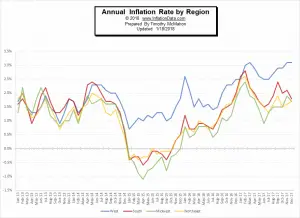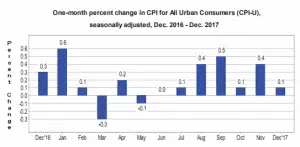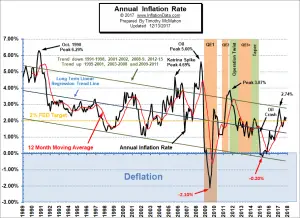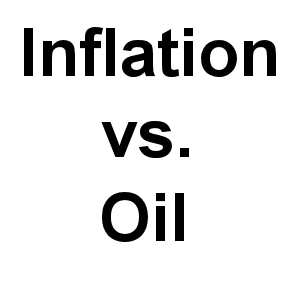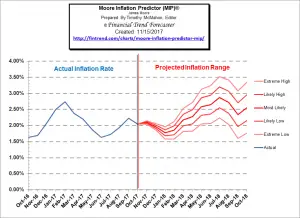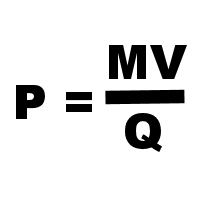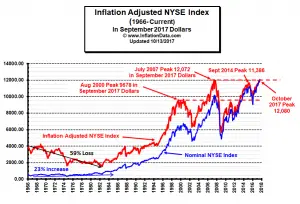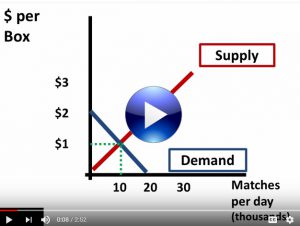Every so often I get a reader who writes a comment accusing me (although the numbers actually come from the Bureau of Labor Statistics) of underestimating the actual inflation rate. He reasons that, since his favorite bread cost $3.00 last year and now it costs $3.50... how can inflation possibly be only 2%? Typically my answer has been that individual items can change but actually cancel each other out. Such as in February 2015 when things like “meat, poultry, fish and eggs” increased 7.6% but energy prices fell enough to make the overall CPI slightly less than zero (i.e. deflationary). But this month we actually see evidence of another explanation. Annual Inflation for the year ending … [Read more...]
Monthly Deflation, Annual Disinflation
The U.S. Bureau of Labor Statistics released the Annual Inflation Rate data for the year through the end of December on January 12th 2018. Annual inflation was 2.11% for the 12 months ending in December CPI-U down slightly from 246.669 to 246.524 Monthly Inflation for December -0.06% Next release February 14th Annual Inflation Chart Annual inflation for the 12 months ending in December 2017 was 2.11% down from 2.20% in November and slightly above the 2.04% in October. Early in 2017 inflation was above current levels at 2.50% in January, 2.74% in February, 2.38% in March, and then falling to 2.20% in April. The annual cyclical low was 0.84% in July 2016. The longer term … [Read more...]
Zero Monthly Inflation, Annual Inflation UP
The U.S. Bureau of Labor Statistics released the Annual Inflation Rate data for the year through the end of November on December 13th 2017. Annual inflation was 2.20% in November up from 2.04% in October CPI-U up slightly from 246.663 to 246.669 Monthly Inflation for November 0.002% Next release January 12th Monthly Inflation is Essentially Zero If the annual inflation rate is negative that is called "deflation" (i.e. prices have gone down since the previous year) but whenever the monthly inflation rate is negative that is called "disinflation" (i.e. prices have gone down since the previous month). That is what happened in October 2017. This month the CPI-U … [Read more...]
How Oil Prices Affect Inflation
For a very long time, the prices of oil and inflation have been closely related to each other. When the value of the precious black liquid goes up, inflation follows in the same direction. The reason for this is because oil is a major commodity that's linked to a lot of things. Oil is used to heat homes, power public utilities, as well as run factories it is also a direct component in things like plastics. That being said, if the input cost for oil rises, so will the costs of finished products and services. The direct association between oil and inflation was first recorded in the 70s. It was at the time when the cost per barrel rose from $3 in 1973 to $40 in the 1979 oil crisis. This … [Read more...]
October Data says Disinflation
The U.S. Bureau of Labor Statistics released the Annual Inflation Rate data for the year through the end of October on November 15th 2017. Annual inflation was 2.04% in October down from 2.23% in September. CPI-U 246.663 Monthly Inflation for October -0.06% Next release December 13th Monthly Inflation is Negative Whenever the monthly inflation rate is negative that is called "disinflation" i.e. prices have gone down since the previous month. If the annual inflation rate is negative that is called "deflation". In October we had disinflation as prices fell slightly (but not below year ago levels). The CPI-U index fell from 246.819 in September to 246.663 in October. … [Read more...]
Ways Inflation Affects the Real Estate Market Pt. 2
In Part 1 of this series on Real Estate and Inflation, we discussed how monetary inflation creates price inflation which affects materials costs, creates a shift into rentals and a surge in foreclosures. But on the flip side, being a commodity itself, home ownership can provide protection against inflation and through the use of a mortgage allows you to pay off an appreciating asset with depreciating dollars. This time we will look at a few more effects of Inflation on the average home buyer. In a period of high inflation, a dollar's value decreases rapidly. On average, a 2 percent inflation rate means that what costs $1 in 2017 would cost roughly $1.02 in 2018. Although inflation is … [Read more...]
Ways Inflation Affects the Real Estate Market
Inflation from January 2007 through December 2016 was extremely low, averaging only 1.77% per year in the U.S. and 2009 was actually negative (i.e. falling prices = deflation). Although 2017 has seen a bit more inflation it is still low by historical standards. In times of low inflation, inflation is a vague term that economists throw around when they’re trying to make one point or another. However, when inflation begins rising and hitting your pocket, the reality begins to set in. And it can have a quite noticeable effect on, not only the goods you buy at your favorite big box store, but even on real estate. Let’s take a quick look at some ways rising (or sinking) prices get their tentacles … [Read more...]
The Quantity Theory of Money
We have written quite extensively on the cause of inflation in articles like: How does the Money Supply affect our Inflation Rate? in What is Inflation? and Inflation Cause and Effects. One of the keys to understanding inflation is the Money Multiplier. Because of the "Fractional Reserve system banks are only required to keep a small fraction of the money on deposit as "reserves" against potential withdrawals the bank can loan out the majority of the money on deposit to earn interest. This results in a multiplication effect increasing the money supply by vast multiples. This "leverage" can work in either direction. In April 2010, I wrote an article explaining how this can result in … [Read more...]
Inflation Up, NYSE New High
Current Inflation Situation On October 13th the Bureau of Labor Statistics released the Consumer Price Index inflation information for September. The CPI-U index was 246.819 up from 245.519 in August. This resulted in an annual inflation rate for the 12 months through September 2017 of 2.23% up from 1.94% in August, 1.63% in June and 1.73% in July. Monthly inflation was a whopping 0.53% for September primarily due to a 12% increase in gasoline prices due to refinery shutdowns in response to hurricanes. See our Annual Inflation Chart for more info. NYSE Makes New High in Inflation Adjusted Terms! To get a true picture of the state of the market it helps to look at the … [Read more...]
3 Ways Natural Disasters Affect Fuel Prices Everywhere
When a natural disaster hits, it's expected that the surrounding region will have difficulties. What's less expected, though, is that the price of fuel goes up everywhere. Even though it happens every time there is a disaster, it's still hard to understand the logic behind the price hikes. Below are three of the reasons why the price of fuel tends to go up everywhere when a natural disaster strikes. Shipping Woes When a disaster strikes, roads are blocked, electric lines get knocked down, emergency services are pushed to the limit, bottled water is in short supply. Even the internet might be gone for days. When this happens, it becomes much harder for fuel companies to ship their products … [Read more...]

